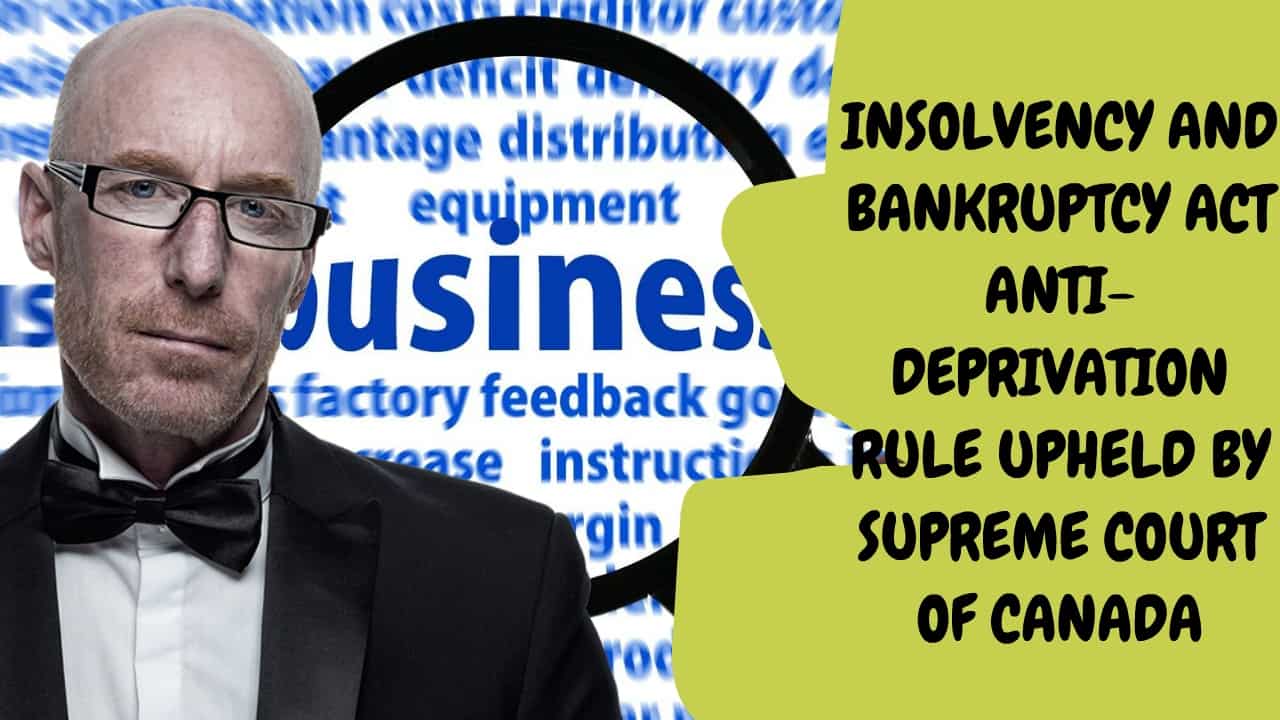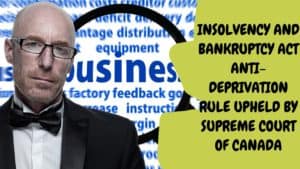
The Ira Smith Trustee Team is absolutely operational and Ira, in addition to Brandon Smith, is readily available for a telephone consultation or video meeting. We hope that you and your family are safe and healthy.
If you would prefer to listen to an audio version of this Brandon’s Blog, please scroll to the very bottom and click on the podcast.
Insolvency and bankruptcy act introduction
On October 2, 2020, the Supreme Court of Canada (SCC) rendered its decision in Chandos Construction Ltd. v. Deloitte Restructuring Inc., 2020 SCC 25 (Chandos decision). This decision upheld the idea that the anti-deprivation rule is completely valid when it pertains to both personal and business insolvency and bankruptcy act cases.
In this Brandon’s Blog, I describe the Chandos case and what it stands for.
The definition of the word deprive and the insolvency and bankruptcy act context
The Merriam-Webster dictionary states the definition of the word deprive is:
- 1: to take something away from; and
- : to withhold something from.
In the Chandos Construction Ltd. (Chandos) insolvency and bankruptcy act case, the SCC was asked to rule on contract clauses that if upheld, would deprive the bankruptcy estate and therefore the unsecured creditors of money that would otherwise be available. This deprivation of funds, which may make total sense as between contracting parties, is not enforceable in bankruptcy.
The anti-deprivation rule in the Canadian insolvency and bankruptcy act matters
Neither the Bankruptcy and Insolvency Act (Canada) (BIA) nor the Companies’ Creditors Arrangement Act (CCAA) stops non-defaulting parties to a contract, from relying upon agreement provisions that create an inevitable result when a debtor declares bankruptcy. The common law becomes pertinent in these situations.
Canadian courts still refer to these anti-deprivation provisions as “ipso facto” provisions and also this idea as the fraud upon the bankruptcy law concept. In more current times, this has been described as the anti-deprivation rule.
The SCC has recognized the anti-deprivation rule since the 1890s. However, the contemporary application of this principle in Canadian law greatly originates from an Ontario court decision in 1995 – Canadian Imperial Bank of Commerce v. Bramalea Inc., 1995 CanLII 7262 (ON SC) (Bramalea decision).
This is a decision from the Ontario Court of Justice (General Division). Canadian courts have thought about and decided upon the anti-deprivation rule in many insolvency and bankruptcy act cases since then.
The Bramalea case and its relevance of insolvency and bankruptcy act matters
Luckily for me, Ira Smith was the receiver responsible for the file that involved the Bramalea decision. So, I have a bird’s-eye view of that case which started it all leading to the SCC Chandos decision.
In the Bramalea insolvency and bankruptcy act case, a group of companies, including Bramalea Inc. (Bramalea) was in a partnership agreement to develop and operate a shopping mall in Markham, Ontario called Shoppes on Steeles. In 1995, Bramalea was placed into receivership and bankruptcy. Bramalea’s partners included Sears Canada and a private real estate development company.
Amongst the different provisions of the partnership agreement was a specific provision in the contract which considers insolvency. It said that, in case of the insolvency of any of the partners, the non-insolvent partner(s) (given it does not waive the event of insolvency) can buy the interest of the financially troubled partner at the lesser of book value or fair market value.
The paradox of this case was that the large company partners at the time of the drafting of the partnership contract were concerned about what happens if the private property developer one day became insolvent? None of the partners ever believed that it would be that private company that would be the only one that was not insolvent. We all know what happened to Sears Canada!
The moving parties sought to exercise that right by serving a notification to buy the Bramalea passion at book value, approximated to be around $200,000. This was opposed by the receiver and also other stakeholders.
The receiver gave evidence that the fair market price surpassed book value by as much as $2 million to $3 million. The moving parties acknowledged that the fair market value of Bramalea’s stake in the partnership was more than book value. They did not agree with the receiver’s evidence regarding the amount of that difference. They additionally did not submit their own fair market valuation.
The Bramalea insolvency and bankruptcy act decision
Based on the evidence, the court took the view that the specific spread between book value and fair market value was not trivial. The court was satisfied that the distinction is greater than marginal, and enough to properly draw the interest of the receiver and the creditors.
The receiver’s position was that there is a higher principle in play and that the concern is not one of hindering the freedom of contract. Rather it was just one of whether or not that part of the partnership contract is void as being contrary to the public interest.
The receiver submitted that while the arrangement might quite possibly stand as between the contracting parties, it is void as against the receiver and also the bankruptcy trustee in the Bramalea insolvency and bankruptcy act proceedings.
The court agreed with the receiver’s position in this insolvency and bankruptcy act case. The court decided that it was clear from the provisions of the partnership agreement itself that the parties contemplated a transfer to one of the partners of the other partner’s partnership interest, only in case of insolvency, at a price less than what could be acquired for that interest on the open market.
The court specified that this stipulation made perfect sense, as between the contracting parties. It made total sense in regards to maintaining their partnership and their respective interests. Nevertheless, the court likewise specified that the clause cannot survive through the scrutiny of the “fraud on the bankruptcy law” principle.
The receiver ended up selling Bramalea’s partnership interest to the other partners for fair market value.

The Chandos Alberta court case and the anti-deprivation rule for insolvency and bankruptcy act matters
Chandos was the general contractor for a condo project contracted with Capital Steel to give $1.3 million worth of steelwork. In the subcontract, Capital Steel agreed that if it became insolvent, Chandos was entitled to all costs arising from the suspension of the contract and it would forfeit 10% of the total subcontract price as an inconvenience fee. Capital Steel performed the majority of its commitments, nevertheless, it filed an assignment in bankruptcy before completing full performance.
As a result, Chandos was forced to finish the contract at an estimated expense of $22,800. Up until that point, Chandos owed Capital Steel $149,618 in outstanding invoices for the job it had performed.
Chandos relied upon the agreement and said that it was qualified to deduct its cost of finishing the job plus 10% of the total contract cost from the amount owing. Given the price of the subcontract, the 10% deduction eliminated Chandos’ balance owing plus an extra amount of $10,511. Chandos declared that gave them a provable claim in the Capital Steel insolvency and bankruptcy act case.
The Trustee’s application to the Alberta Court of Queen’s Bench
On March 6, 2017, the Trustee applied to the Alberta Court of Queen’s Bench seeking advice and directions on whether Chandos was entitled to rely on the provision in the contract or was it void pursuant to the anti-deprivation rule in common-law.
The chambers judge acknowledged that the common law anti-deprivation rule stops parties from contracting out of insolvency and bankruptcy act regulations. The judge stated that if that provision was a liquidating damages provision as opposed to a penalty, it would not violate the rule.
The chambers judge ruled that the condition was an authentic pre-estimate of costs, which imposed liquidated damages and not a penalty. He additionally held that the provision represented a bona fide commercial arrangement that did not have as its predominant objective the deprivation of Capital Steel’s property. Consequently, the chambers judge decided that Chandos can implement the clause against the Trustee.
Trustee appeals the Chandos insolvency and bankruptcy act decision to the Court of Appeal for Alberta
The Trustee appealed the Chandos decision to the Court of Appeal for Alberta. The appellate court reviewed the lower court decision in this insolvency and bankruptcy act case and decided that:
- The chambers court properly determined the presence and application of the fraud on the bankruptcy law principle in Canada.
- In describing the scope of the anti-deprivation rule, however, the chambers judge erred.
- The lower court embraced the purpose-based technique set out by the Supreme Court of the United Kingdom
- The appropriate technique is to check out the impact of the provision. Its purpose is a different analysis.
- Chandos certainly had a genuine commercial interest it was looking to protect.
- However, the clause conflicts with the BIA‘s scheme of distribution. The common law anti-deprivation rule revokes the clause and Chandos cannot count on it to defend its claim against the Trustee.
Chandos appeals to the SCC in this insolvency and bankruptcy act anti-deprivation rule case
One of the key goals of the insolvency and bankruptcy act law is to make certain there is a fair distribution among creditors. In order to fulfill the objective, the legislation restricts specific contractual stipulations that trigger when one of the parties goes into insolvency proceedings (ipso facto clauses).
As seen in the Bramalea situation, one of these limitations is the anti-deprivation rule. It holds that ipso facto conditions that rob the debtor’s creditors of assets they are qualified to receive in insolvency and bankruptcy act matters are void. This is likewise what the Court of Appeal for Alberta decided. Chandos appealed that decision to the SCC.
The Chandos appeal was heard on January 20, 2020. The SCC split decision was released on October 2, 2020. On the facts of Chandos, the SCC dismissed the Chandos appeal. The SCC refused to promote a contractual stipulation that the subcontractor Capital Steel waive 10 percent of the agreed price if Capital Steel became insolvent or bankrupt.
The SCC majority maintained that the test for application of the contractual provision is effects-based and not purpose-based. The SCC majority confirmed that the anti-deprivation rule stands under Canadian common law and it has not been eliminated in dismissing the appeal in this corporate insolvency and bankruptcy act case.

Insolvency and bankruptcy act summary
I hope you have enjoyed this insolvency and bankruptcy act Brandon’s Blog. Hopefully, you have better insight now into the fact that a sick insolvent company’s business can be saved by doing a sale of its assets to a healthy organization.
Do you or your company have too much debt? Are you or your company in need of financial restructuring? The financial restructuring process is complex. The Ira Smith Team understands how to do a complex restructuring. However, more importantly, we understand the needs of the entrepreneur or the person who has too much personal debt.
You are worried because you are facing significant financial challenges. It is not your fault that you are in this situation. You have been only shown the old ways that do not work anymore. The Ira Smith Team uses new modern ways to get you out of your debt troubles while avoiding bankruptcy. We can get you debt relief freedom.
The stress placed upon you is huge. We understand your pain points. We look at your entire situation and devise a strategy that is as unique as you and your problems; financial and emotional. The way we take the load off of your shoulders and devise a debt settlement plan, we know that we can help you.
We know that people facing financial problems need realistic lifeline. There is no “one solution fits all” approach with the Ira Smith Team.
That is why we can develop a restructuring process as unique as the financial problems and pain you are facing. If any of this sounds familiar to you and you are serious in finding a solution, contact the Ira Smith Trustee & Receiver Inc. team today.
Call us now for a free consultation.
We will get you or your company back on the road to healthy stress-free operations and recover from the pain points in your life, Starting Over, Starting Now.
The Ira Smith Trustee Team is absolutely operational and Ira, in addition to Brandon Smith, is readily available for a telephone consultation or video meeting. We hope that you and your family are safe and healthy.



 Introduction
Introduction